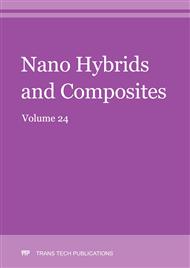[1]
Santamaría A., Orbe A., Losañez M.M., Skaf M., Ortega-Lopez V., Gonzalez J.J. (2017) Selfcompacting concrete incorporating electric arc-furnace steelmaking slag as aggregate. Mater Des 115: 179-193.
DOI: 10.1016/j.matdes.2016.11.048
Google Scholar
[2]
Abu-Eishah S.I., El-Dieb A.S., Bedir M.S. (2012) Performance of concrete mixtures made with electric arc furnace (EAF) steel slag aggregate produced in the Arabian Gulf region. Constr Build Mater 34: 249-256.
DOI: 10.1016/j.conbuildmat.2012.02.012
Google Scholar
[3]
Lee Y.-J., Lee J.-M., Wang C.-J., Kim S.-W., Kim H.-G., Kim K.-H. (2018) Compressive stress distribution of concrete with EAF oxidizing slag aggregates. Mag Concr Res 70(7): 365-378.
DOI: 10.1680/jmacr.16.00440
Google Scholar
[4]
Kırgız, M.S., Effect of mineralogical substitution raw material mixing ratio on mechanical properties of concrete, ZKG International, No. 10, p.30–41, (2018).
Google Scholar
[5]
Kırgız, M.S., Experimental study on pH-assisted bending strength gain projection for green mortar composite containing brick powder as substitution by-product, European Journal of Environmental and Civil Engineering, 2017.
DOI: 10.1080/19648189.2017.1357740
Google Scholar
[6]
Kırgız, M.S., Fresh and Hardened Properties of Green Binder Concrete Containing Marble Powder and Brick Powder, European Journal of Environmental and Civil Engineering, Issue sup1: Supplement: Green Binder Materials for Civil Engineering and Architecture Applications, Vol. 20, pp.64-101, 2016.
DOI: 10.1080/19648189.2016.1246692
Google Scholar
[7]
Kırgız, M.S., Strength Gain Mechanism for Green Mortar Substituted Marble Powder and Brick Powder for Portland Cement, European Journal of Environmental and Civil Engineering, Issue sup1: Supplement: Green Binder Materials for Civil Engineering and Architecture Applications, Vol. 20, pp.38-63, 2016.
DOI: 10.1080/19648189.2016.1246691
Google Scholar
[8]
Kırgız, M.S., Advance Treatment by Nanographite for Portland Pulverised Fly Ash Cement (The class F) Systems,, Composites Part B: Engineering, Vol. 82, No. 12, p.59–71, 2015.
DOI: 10.1016/j.compositesb.2015.08.003
Google Scholar
[9]
Kırgız, M.S., Use of ultrafine marble and brick particles as raw materials in cement manufacturing,, Materials and Structures, Vol. 48, No. 9, p.2929–2941, (2015).
DOI: 10.1617/s11527-014-0368-6
Google Scholar
[10]
Kırgız, M.S., Strength Gain Mechanisms of Blended-Cements Containing Marble Powder and Brick Powder,, KSCE Journal of Civil Engineering, Vol. 19, No.1, p.165–172, 2015.
DOI: 10.1007/s12205-014-0557-4
Google Scholar
[11]
Kırgız, M.S., Use of ultrafine marble and brick particles as alternative raw materials for clinkerization,, ZKG International, No.4, p.36–44, (2014).
Google Scholar
[12]
Kırgız, M.S., Effects of Blended–Cement Paste Chemical Composition Changes on Some Strength Gains of Blended–Mortars,, Materials Science / Journal of Scientific World, Vol.2014, pp.1-11, 2014.
DOI: 10.1155/2014/625350
Google Scholar
[13]
Kırgız, M. S., Chemical properties of blended cement pastes,, Journal of Construction Engineering and Management, Vol. 137, No. 12, p.1036–1042, 2011.
Google Scholar
[14]
Papachristoforou M., Papayianni I. (2018) Radiation shielding and mechanical properties of steel fiber reinforced concrete (SFRC) produced with EAF slag aggregates. Radiation Physics and Chemistry 149: 26-32.
DOI: 10.1016/j.radphyschem.2018.03.010
Google Scholar
[15]
Zhang T., Gjørv O.E. (2005) Effect of chloride source concentration on chloride diffusivity in concrete. ACI Mater. J. 102: 295–298.
DOI: 10.14359/14707
Google Scholar


